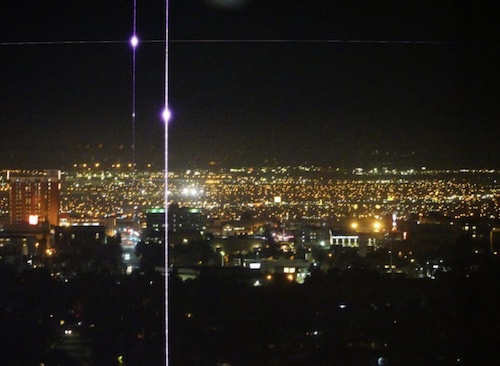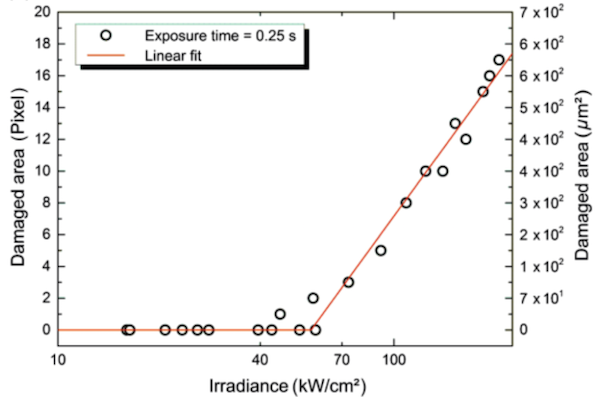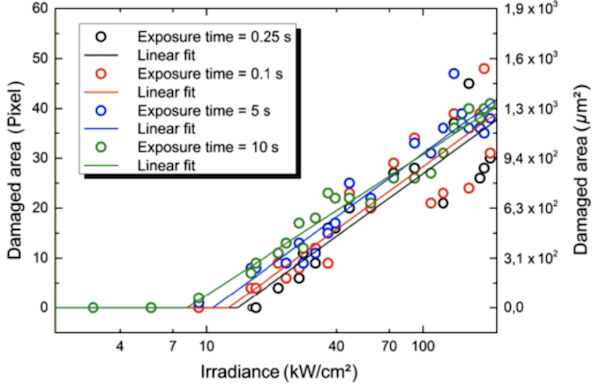Home
A comprehensive resource for safe and responsible laser use
If your camera is hit by a laser beam
Lasers emit concentrated beams of light, which can heat up sensitive surfaces (like the eye's retina) and cause damage. Camera sensors are, in general, more susceptible to damage than the human eye.
For large scale shows such as televised concerts, laser show producers work with clients to avoid TV camera locations and video projectors (ILDA Members, see this page for details; login required). However, it is not possible for laser show producers to be responsible for all cameras, smartphones and camcorders which might be used at a show.
Topics
-
Tips for audience members with cameras when lasers are in use
- If you attend a laser show as an audience member, you should take reasonable precautions not to let a laser beam DIRECTLY enter your camera lens.
- You can photograph the beams in midair, or doing graphics on a screen. If you can't see the laser source (projector output aperture or bounce mirror) in your viewfinder, this means you're not getting the full beam power into your lens. Indirect viewing like this should not cause damage.
- Avoid beams which are coming straight into your lens (or bounced off a mirror or other reflective surface and then into your lens). The damage potential is much greater when the entire beam power enters the camera lens.
-
Degree of camera damage
- The degree of damage can vary widely.
- We have seen cases of minor damage, such as small areas of a few pixels which no longer work. The pixels are not noticeable unless in an area of uniform color such as a blue sky.
- In more extreme cases, there may be larger or more extensive dead-pixel areas. Or there may be "burn in" of a laser image. The damage is readily noticeable in most photos or videos. In this case, the camera is ruined for quality use. The image below shows numerous laser-caused spots on an HP Photosmart 945, a 5-megapixel camera. Click on the image to see the full-size (100%) original photograph. (Photo courtesy Aljaž Ogrin.)

Click on photo for full-size version- Damage to one spot may result in a horizontal or vertical line. In this case, data from the entire row or column of sensors can no longer be read out properly.
Search YouTube and other internet sources for videos and pictures of laser-caused damage. See for example Laser light kills Canon 5D Mark II, or Concert lasers destroy RED EPIC image sensor.
Note that not all claims of laser damage are valid. In March 2009, we reviewed a case where it was claimed that a Fuji F60fd 12-megapixel point-and-shoot camera was severely damaged by a laser. ILDA analyzed video from the camera, and determined the probable cause to be a very bright white light. Also, this YouTube video shows a standard camera flash (speedlight) causing severe damage to a CCD sensor in an instant. -
Eye safety is most important
- The primary safety concern for laserists is that the show is eye-safe. A good working definition of "eye-safe" is that everyone leaves the show with the same vision they entered -- there is no detrimental change to a person's vision. International safety standard ANSI Z136 sets "Maximum Permissible Exposure" levels for laser light. Shows done at or below the MPE should cause no problem for human eyes. Even shows which exceed the MPE have remarkably safe records. There have been only a handful of documented or proven eye injuries out of at least 163,000,000 persons viewing continuous-wave laser shows over 45 years.
However, there are no MPEs for sensors such as CMOS or CCD chips. This means a show may be perfectly safe for eyes, but could possibly damage a camera sensor. One reason is that camera lenses may gather more laser light, and concentrate it to a finer point. Another reason is that CMOS or CCD sensors are more easily damaged than the eye.
Due to the many varying factors involved with lenses and sensors, laser show producers cannot be responsible for audience-member damage to cameras or camcorders. -
Surveillance cameras easily damaged by lasers, but are harder to fully obscure
- IPVM, a research group focusing on surveillance cameras, tested different powers of lasers being used against three types of security cameras, from various distances.
The researchers' found it was easy to temporarily "blind" a camera since the bright laser light overwhelms the sensor's view. But it was difficult to keep the laser steady on the sensor.
In a YouTube video they said "It is very difficult for a human to train a laser on an object from roughly five feet away and further without their hands shaking off target. We found that using a clamp to clamp the laser steady to a stationary object to be the best means of consistently blinding a camera from roughly 50 feet away or further."
In terms of causing permanent damage to sensor pixels, to the whole sensor or to the lens, IPVM summarized as follows:- "Close range required: Permanent damage did not occur from distance of ~50 feet or further from the camera, regardless of the strength of the laser we tested."
- "Aiming by hand difficult: Targeting a laser towards a camera is difficult from more than ~10' away. Attaching the laser to a stationary object for aiming makes sensor damage much more likely."
Lasers used included low-powered laser pointers in the 5 milliwatt range (legal for sale in the U.S. as laser pointers) and high-powered handheld lasers. The group said the two high-powered lasers were around 30,000 mW (30 watts) but that is extremely unlikely. They probably were closer to 3,000 mW (3 watts).
The security camera sensors could be damaged at various powers and distances. But IPVM found it was much more difficult to cause permanent damage that rendered the cameras completely useless for surveillance purposes.
For more details, see the September 25, 2019 IPVM report "Lasers Impact on Surveillance Cameras Tested." -
Tattoo laser causes camera damage
- In March 2019, a YouTube video showed laser tattoo removal damaging a high-end digital camera sensor just by taking a video of the laser pulses on the skin.
The laser beam did NOT directly enter the Sony A7SII lens. And yet with every tattoo removal pulse, the camera sensor was obviously damaged. According to the person posting the video, "The repair cost was about as much as a new camera [about $2200] so try to avoid this."
If a laser is powerful enough, just looking at the dot of the laser on a wall can be a "diffuse reflectance hazard." The laser being used was much more powerful than a laser pointer or handheld laser. It generated very short, very powerful pulses of light (around 1-2 Joules at 5-10 nanoseconds), while pointer-type lasers almost always emit continuous wave light.
Everyone in the room should have been wearing laser safety glasses or goggles that reduce the reflected laser light to safe levels. If the camera had been shooting through the safety glasses' lens, the damage likely would not have occurred
The camera sensor damage seen in the video is not a flaw in the laser or the camera. As described elsewhere on this page, camera sensors are generally more sensitive than the eye.
Also as noted, different cameras may have different sensitivities depending on many factors. For example, this page includes four YouTube videos showing laser tattoo removal, without any apparent damage to the video sensor. -
Self-driving car lidar laser causes camera damage
- In early January 2019, a man attending the CES technology show in Las Vegas claimed his Sony A7RII camera's sensor was damaged by non-visible infrared laser light from lidar used by a company called AEye.

More on the claim, and links to lidar information, is here.
-
More information on sensor damage
- A webpage called “Analysis of Laser Light Threat to CCTV” gives a good general overview of what power ranges and usage patterns might damage camera sensors.
A July 2014 Master’s thesis by Sacha Casken goes into detail about the effect of lasers on common point-and-shoot camera sensors. This appears to be the first published laboratory test of lasers on consumer-type sensors. A summary, reprinted by permission of Cranfield University, is available here.
A March 2017 article in the journal Optical Engineering looked at laser damage to CMOS and CCD sensors, and to digital micromirror devices (DMDs) used in video projectors. The authors looked at both pulsed lasers and continuous wave lasers. Since CW lasers are more common for consumer uses such as pointers, handhelds, and light show projectors, we are presenting only the CW laser beam results.
This graph shows that damage to a color CMOS sensor starts at around 40,000 to 60,000 watts per square centimeter for an exposure of 0.25 seconds:
However, a color CCD sensor is more vulnerable. Damage begins to occur at around 16,000 W/cm2 for 0.25 and 0.1 second exposures (black and red lines) and at around 9,000 W/cm2 for exposures of 5 and 10 seconds (blue and green lines):

Incidentally, the authors found that a digital micromirror device (DMD) commonly used in video projectors had a damage threshold of about 19,000 W/cm2.
For comparison, a 5 mW laser pointer at a 1 foot distance has an irradiance of 0.374 W/cm2. After magnification by the lens of the eye, the same laser’s irradiance on the retina is 440 W/cm2.
So, assuming a camera has a lens with similar magnification as the eye's lens, an irradiance of 440 W/cm2 is well below the damage threshold of 40,000 W/cm2 for a CMOS sensor or 16,000 W/cm2 for a CCD sensor. (This assumption may not hold since camera sensors have been known to be damaged by relatively low powered lasers aimed directly into the lens.)
Jan 14 2019: Corrected CMOS text description which was previously off by a factor of 1000. Thanks to Dominik Jančik for pointing this out.. -
More information on eye safety at laser light shows
- ILDA has presented information about audience-scanning laser shows in the scientific paper "Scanning Audiences at Laser Shows: Theory, Practice and a Proposal". This gives some reasons why even shows which are well above the MPE have not caused any apparent eye changes in millions of audience members. Some of the reasons may also be relevant to why some camera sensors are damaged while many others are not.
-
More information for ILDA Members
- Members of the International Laser Display Association can get more specific information on avoiding camera and video projector damage, on this page (login required).
-
Additional news
- In September 2014, a leaked copy of Apple’s guide to iPhone damage, furnished to its authorized repair centers, listed “Damage due to laser contact with camera” as an Out-of-Warranty Service item. See this LaserPointerSafety.com news story for more information.
In early 2019, Epson introduced two video projectors which include a mechanical shutter that can close to prevent laser light from reaching the sensor. The two models are EB-L12000Q and EB-L20000U. This news came from at least two sources, The Jakarta Post and WorshipAVL.
